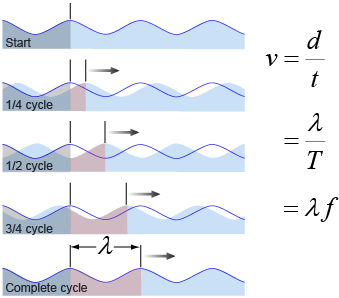|
The speed of a wave is not quite the same as the speed of a moving object. Think about dropping a stone into a pond in which a ball is floating a few meters away. When the ripples reach the ball, the ball oscillates up and down. The speed of the wave is the speed at which the ripples spread out from where the stone fell. Physicists use the word propagate, which means to “spread out and grow.” The speed of a wave is the speed at which the wave propagates, or spreads itself out. 
|

|
 As a wave moves forward, it advances one wavelength with each complete cycle. Speed is distance divided by time, and therefore the speed of a wave is its wavelength λ divided by the period T of its cycle. Since the frequency is the inverse of the period (f = 1 / T) we usually write the speed of a wave in terms of frequency and wavelength. The result is true for sound waves, light waves, and even gravity waves. Frequency multiplied by wavelength is the speed of the wave.
As a wave moves forward, it advances one wavelength with each complete cycle. Speed is distance divided by time, and therefore the speed of a wave is its wavelength λ divided by the period T of its cycle. Since the frequency is the inverse of the period (f = 1 / T) we usually write the speed of a wave in terms of frequency and wavelength. The result is true for sound waves, light waves, and even gravity waves. Frequency multiplied by wavelength is the speed of the wave. 
|
| (15.1) | | | v | = | speed of the wave (m/s) | | f | = | frequency (Hz) | | λ | = | wavelength (m) |
| Speed, frequency, and
wavelength of a wave
|
|
Waves have a wide range of speeds. Lab-sized water waves are fairly slow; a few miles per hour, or 0–5 m/s, is typical. Deep ocean waves, such as tsunamis, can be much faster, reaching 600 mph (268 m/s) or more—as fast as a jet airliner! Light waves are extremely fast—300,000 kilometers per second, which is 3×108 m/s or 671,000,000 mph. Sound waves travel at about 343 m/s in air—faster than water waves but much slower than light. 
|
Two men use a long spring to create a wave. The wavelength is 2 m and the frequency is 2 Hz. How fast is the wave traveling along the spring? | Asked: | speed v of the wave (“how fast”) | | Given: | wavelength λ = 2 m, frequency f = 2 Hz | | Relationships: | v = f λ | | Solution: | Insert the values into the equation: | | Answer: | The wave travels at 4 m/s. | 
|
|
Sound waves travel faster through water (1,500 m/s) than they do through air (343 m/s). Sound waves also generally travel faster through solids than through liquids. A seismic wave may travel at 2,000 to 8,000 m/s through the Earth’s crust.
|
FM radio waves travel at a speed of 300,000,000 m/s and may have a frequency of 100,000,000 Hz. What is the wavelength of such a wave?
 |
This wave has a wavelength of 3 m. Use and solve for the wavelength λ: 
|
| |
|

